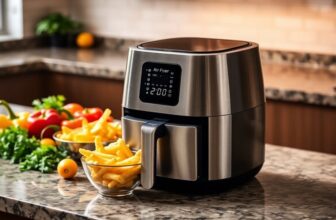Tips for Maintaining Your Coffee Maker
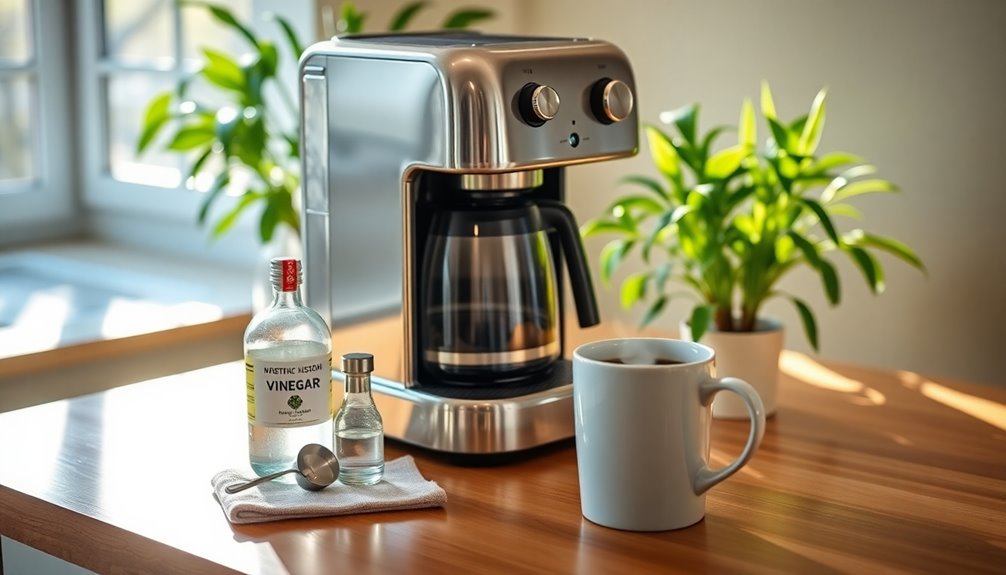
To maintain your coffee maker's performance, establish a regular cleaning schedule. Clean removable parts, like filters and brew baskets, after each use with warm, soapy water. Wipe down the exterior with a damp cloth to prevent grime buildup. Use filtered water to enhance flavor and reduce mineral deposits, and descale your machine monthly for hard water areas. Regularly check the condition of carafes and filters, replacing them as needed. Store the coffee maker in a clean, dry area, and avoid overloading it. Continuously monitoring these aspects will guarantee your coffee maker lasts longer and brews better, so keep exploring for more insights.
Key Takeaways
- Clean removable parts like filters and brew baskets with warm, soapy water after each use to prevent coffee oil buildup.
- Use filtered water for brewing to enhance flavor and reduce mineral buildup in your coffee maker.
- Descale your coffee maker monthly for hard water areas, or every three months for filtered water, using a high-quality descaling solution.
- Wipe down the exterior and water reservoir with a damp cloth after each use to prevent dust, grime, and stagnation.
- Store your coffee maker in a cool, dry place, covering it to protect from dust and removing water reservoirs if stored long-term.
Regular Cleaning Schedule
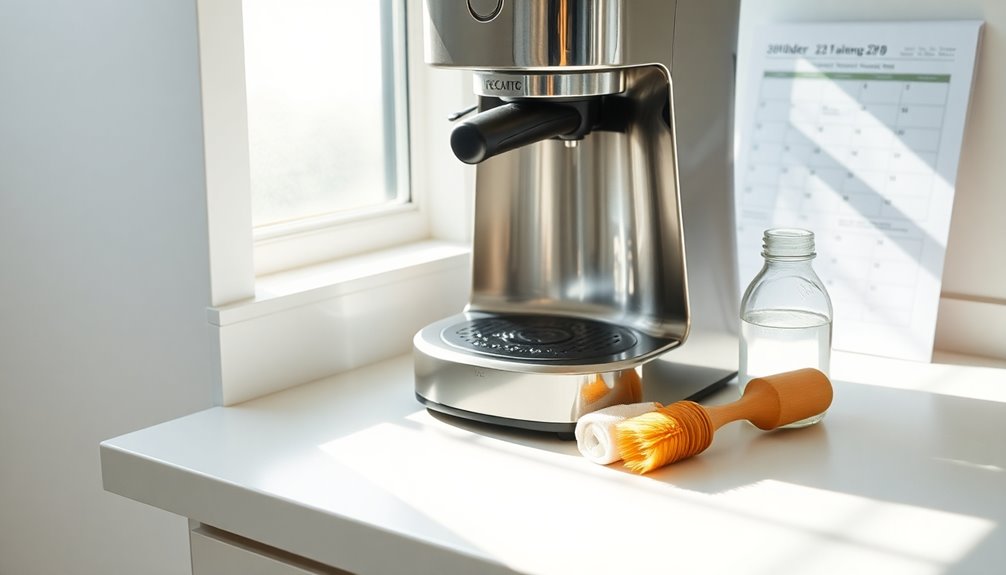
To keep your coffee maker in prime condition, establish a regular cleaning schedule. Consistency is key when it comes to maintaining the performance and longevity of your coffee machine. Aim for a cleaning frequency that suits your usage; for daily brewers, a weekly cleaning is advisable, while those using their machines less frequently might consider a bi-weekly schedule.
Start by gathering your cleaning tools. Basic tools include a soft cloth, a sponge, white vinegar, and a mild dish soap. Vinegar is particularly effective for descaling, as it helps remove mineral buildup that can affect both taste and functionality.
If your machine includes removable parts, like filters or brew baskets, wash them with warm, soapy water during each cleaning session. This not only keeps them hygienic but also guarantees ideal brewing conditions.
To clean your coffee maker, fill the reservoir with equal parts water and vinegar, and run a brewing cycle without coffee grounds. Follow this with two cycles of plain water to rinse out any residue.
Regularly cleaning the exterior with a damp cloth prevents dust and grime from accumulating, enhancing both appearance and hygiene.
Use Filtered Water
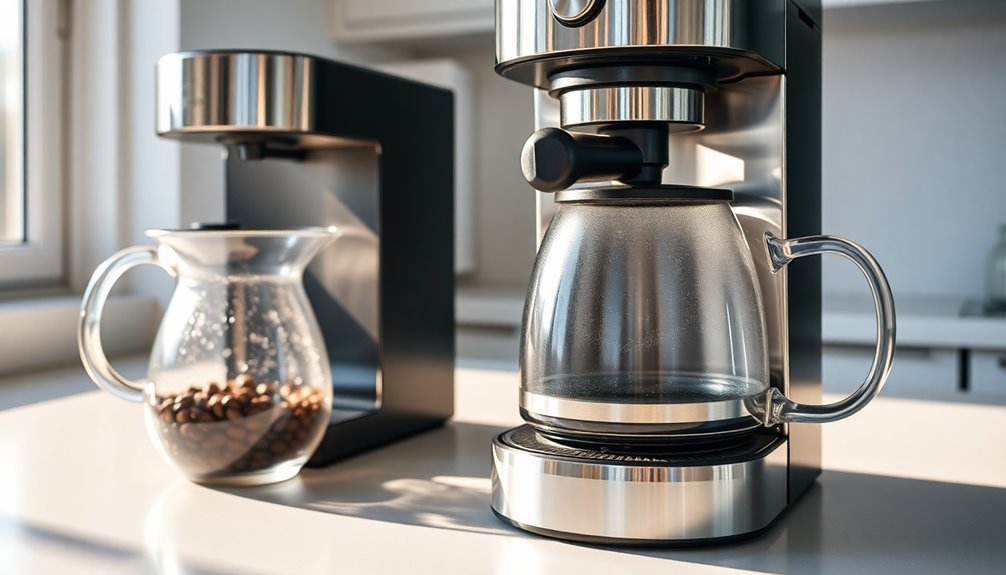
Water quality plays an essential role in the taste and overall performance of your coffee maker. When you use filtered water, you greatly enhance the flavor of your coffee while also prolonging the life of your machine. Tap water often contains minerals and impurities that can lead to unwanted tastes and odors, affecting your coffee experience. By choosing filtered water, you eliminate these variables, ensuring that each cup you brew is clean and flavorful.
Additionally, using filtered water reduces the risk of mineral buildup within your coffee maker. Hard water, which contains high levels of calcium and magnesium, can create scaling that impairs your machine's functionality. This buildup can clog internal components and affect brewing efficiency, ultimately leading to costly repairs or replacements.
Filtered water not only helps maintain your coffee maker but also contributes to a consistent brewing process, allowing you to enjoy your favorite coffee blends to their fullest potential. Whether you use a water filter pitcher, an under-sink filtration system, or a built-in filter in your coffee maker, you'll notice the difference in both taste and performance.
Incorporating filtered water into your coffee routine is a simple yet effective way to enhance your coffee experience and maintain your machine. As you savor each cup, you'll feel a sense of belonging to a community of coffee enthusiasts who prioritize quality and care for their equipment.
Descale Your Machine

Using filtered water greatly reduces mineral buildup, but even with this practice, regular descaling is necessary to keep your coffee maker in top shape.
Over time, limescale can accumulate in your machine, affecting performance and the taste of your coffee. To guarantee your coffee maker operates efficiently, follow these frequency recommendations for descaling:
- Monthly Descaling: If you live in an area with hard water, consider descaling your coffee maker every month. This will help prevent heavy buildup.
- Every 3 Months: For those using filtered water, a descaling every three months is typically sufficient. This timeframe balances maintenance without being excessive.
- Use Descaling Solutions: Always opt for a high-quality descaling solution designed for coffee makers. Avoid vinegar as it can damage internal components over time.
- Follow Manufacturer's Instructions: Each coffee maker can have unique requirements, so always refer to the user manual for specific descaling instructions tailored to your model.
Replace Coffee Filters
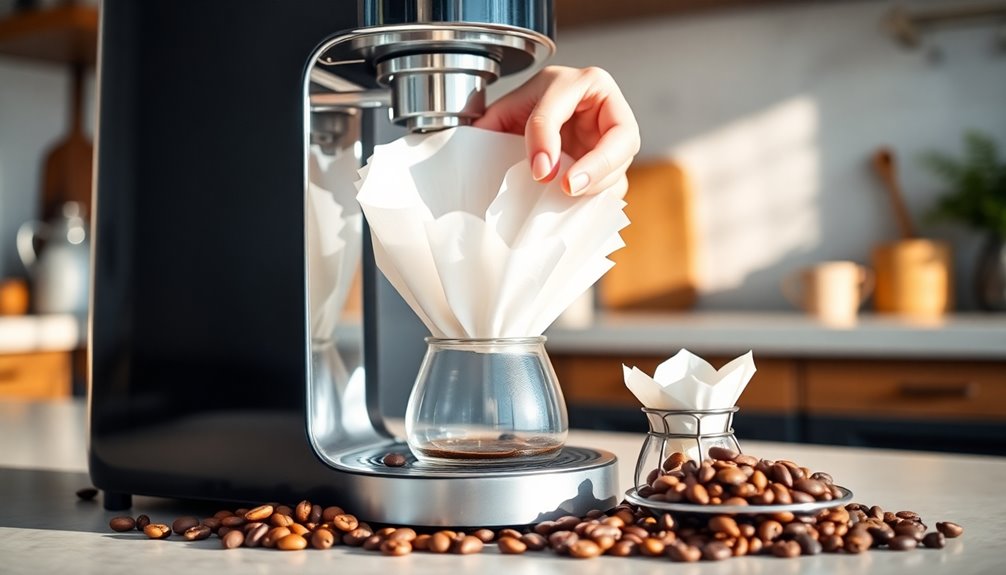
Although you mightn't think about it often, regularly replacing your coffee filters is necessary for brewing the best-tasting coffee. Over time, used filters can accumulate oils and residues that negatively impact flavor, resulting in a less enjoyable cup.
Different coffee filter types, such as paper, metal, and cloth, each have their own maintenance needs. It's important to choose the right type for your machine, as this can influence both taste and the filter replacement frequency.
If you use paper filters, it's generally recommended to replace them with each brew. For metal filters, cleaning after every use is essential to prevent buildup and guarantee pure flavor. Cloth filters should be rinsed thoroughly and replaced every few months, depending on usage.
You want to keep your coffee experience consistent, right? Regularly evaluating your filter condition will help you maintain that quality.
As part of your coffee care routine, establish a filter replacement schedule that works for you. For those who drink multiple cups daily, consider checking your filters weekly. If your consumption is lower, a monthly check might suffice.
Check Brew Temperature

After confirming your coffee filters are in top shape, the next step in improving your brewing process is checking the brew temperature.
The temperature at which you brew your coffee greatly affects the flavor and aroma, directly influencing the ideal extraction of essential oils and flavors. For the best results, aim for a brewing temperature between 195°F and 205°F (90°C to 96°C).
To verify your coffee maker is operating at the correct temperature, consider the following steps:
- Use a Thermometer: Invest in a reliable thermometer to measure the brew water temperature directly. This will give you accurate data to work with.
- Check Brew Time: Monitor the brew time and verify it aligns with the recommended duration for your coffee type. Over-extraction can occur if the brew time is too long, leading to bitterness.
- Inspect Heating Elements: Regularly check the heating elements of your coffee maker for any signs of wear or malfunction. A faulty heater may not maintain the correct temperature.
- Run a Test Brew: Periodically run a test brew without coffee grounds to check the water temperature. This can help you gauge the performance of your machine and make necessary adjustments.
Maintain the Carafe
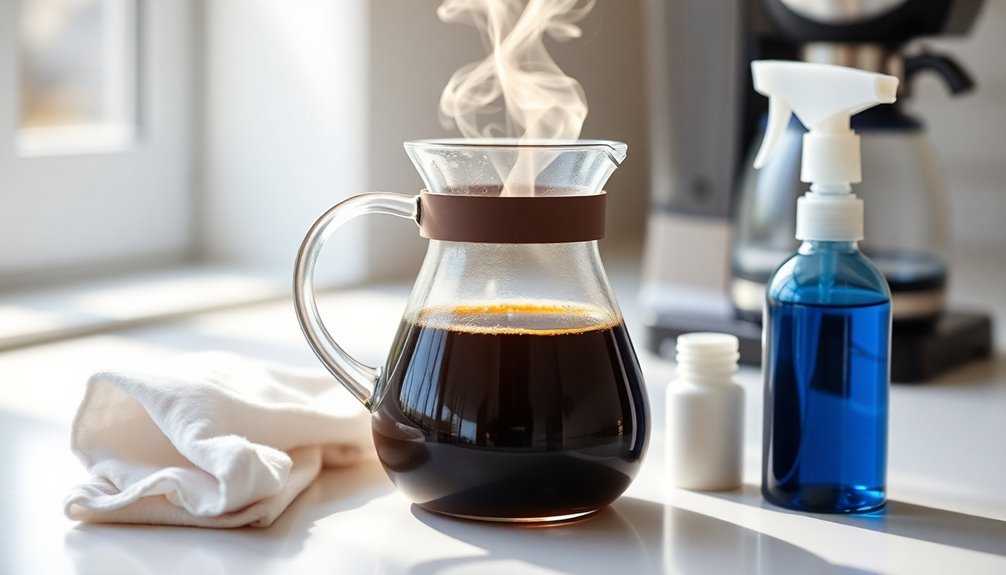
Maintaining the carafe is vital for guaranteeing the quality of your brewed coffee. The carafe is often the first point of contact for your coffee once it's brewed, so keeping it clean and in good condition directly impacts flavor and aroma.
Different carafe materials—such as glass, stainless steel, and ceramic—each require specific care to maintain their integrity and performance.
For glass carafes, avoid sudden temperature changes, as they can crack. Regularly washing them with warm, soapy water helps eliminate coffee stains and oil buildup.
For stainless steel carafes, use a gentle scrubber and avoid abrasive cleaners that can scratch the surface. Their vacuum-sealed nature often keeps coffee hot longer, so maintaining the seal is essential for ideal performance.
Consider the shape of your carafe, too. Narrow-neck carafes can be more challenging to clean than those with a wider opening. If you have a narrow carafe, use a specialized cleaning tool or a mixture of baking soda and water to reach the bottom.
Always guarantee you rinse thoroughly after cleaning, regardless of the material or shape, to prevent any residue from affecting your next brew.
Inspect and Clean Parts
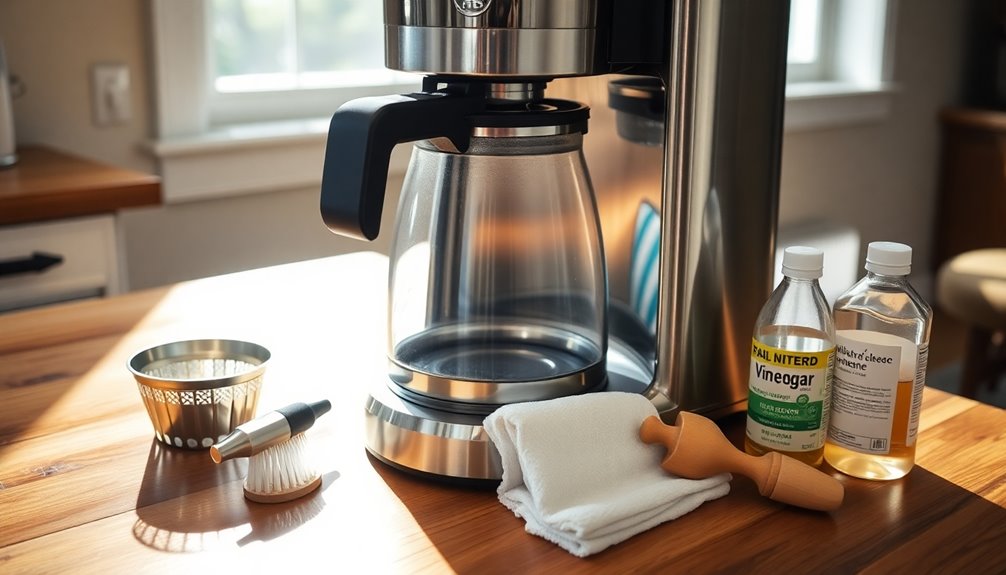
Regularly inspecting and cleaning the parts of your coffee maker is essential for peak performance and longevity.
By taking a few moments to maintain your machine, you'll guarantee that every cup of coffee tastes fresh and delicious.
Here are some key components you should focus on:
- Water Reservoir: Remove and inspect the water reservoir for any buildup or residue. Rinse it thoroughly to eliminate any lingering impurities.
- Filter Basket: After each use, clean the filter basket to prevent coffee oils from accumulating. If you're using a permanent filter, make sure to wash it regularly to maintain optimal flavor.
- Spray Head: Check the spray head for clogs or blockages. You can use a soft brush or a damp cloth to clean the exterior and guarantee water flows evenly during brewing.
- Exterior Surfaces: Don't forget to clean the exterior of your coffee maker. Wipe down surfaces with a damp cloth to remove spills and dust, helping your machine look its best.
Store Properly
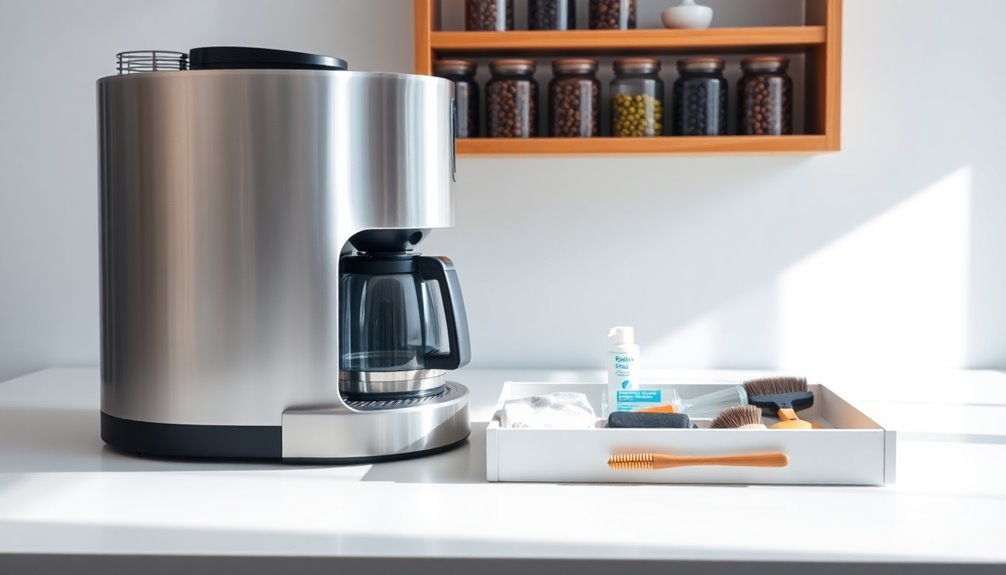
When it comes to storing your coffee maker, proper care can greatly extend its lifespan and maintain its performance. To guarantee your machine stays in peak condition, begin by selecting a suitable location for coffee storage. Avoid areas with excessive heat or moisture, such as near stoves or sinks, as these can damage the internal components over time.
Instead, opt for a clean, dry area where the coffee maker can be easily accessed but remains out of direct sunlight. Consider placing it on a stable countertop or in a dedicated cabinet to prevent accidental bumps or spills. Proper placement is essential; you want your coffee maker to be positioned where it won't be jostled or knocked over.
Before storing, always make sure the coffee maker is completely cool and clean. Remove any leftover coffee grounds, and wash the carafe and filter basket thoroughly. This not only prevents residue build-up but also guarantees your next brew tastes fresh.
If possible, keep the coffee maker covered with a cloth or a manufacturer-supplied cover to protect it from dust and debris.
If you're storing your coffee maker for an extended period, consider removing any water reservoirs to prevent stagnation and mold growth.
Avoid Overloading
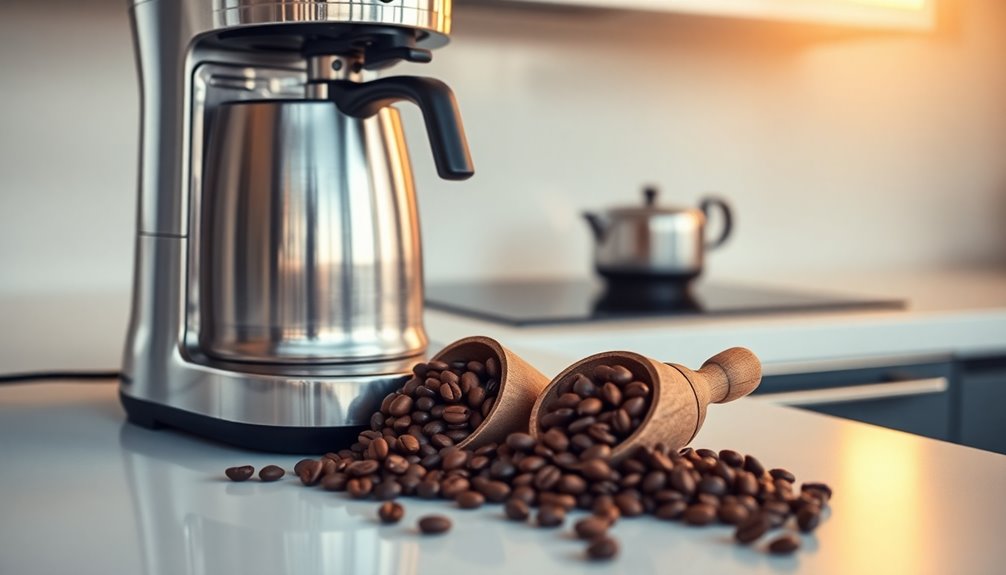
Overloading your coffee maker can lead to a range of issues, from poor brewing performance to potential damage. Each coffee maker has a specific coffee capacity, and exceeding this limit compromises not only the flavor but also the longevity of the machine.
When you overload, you disrupt the brewing efficiency, leading to uneven extraction and a bitter or weak cup of coffee. To maintain ideal performance, adhere to the following guidelines:
- Know Your Limits: Understand the maximum capacity of your coffee maker. This information is typically found in the user manual or on the manufacturer's website.
- Measure Accurately: Use a coffee scale or measuring spoon to guarantee you're adding the right amount of coffee grounds. A general rule is to use one to two tablespoons of coffee per six ounces of water.
- Brew in Batches: If you need more coffee than your machine can handle, consider brewing multiple smaller batches instead of one large pot. This method preserves flavor and prevents clogging.
- Regular Maintenance: Frequent overloading can lead to build-up and clogs in your coffee maker. Clean your machine regularly to prevent these issues, guaranteeing it operates efficiently.
Follow Manufacturer Guidelines

Your coffee maker is a finely-tuned machine designed to brew the perfect cup, and following the manufacturer's guidelines is vital for its ideal performance. By adhering to the manufacturer recommendations, you guarantee your coffee maker operates efficiently and lasts longer. Each model has specific requirements regarding cleaning, descaling, and other maintenance tasks, which are critical for maximizing its functionality.
Creating a maintenance schedule based on these guidelines helps you stay on track. Regular maintenance not only enhances the taste of your coffee but also prevents costly repairs down the line. Here's a simplified table to help you remember key tasks:
| Maintenance Task | Frequency |
|---|---|
| Clean removable parts | After each use |
| Descale | Every 1-3 months |
| Replace water filters | Every 2 months |
| Check power cord & plug | Monthly |
Following this maintenance schedule can lead to a more enjoyable brewing experience. Remember, neglecting these recommendations might result in subpar coffee or even damage to your machine. By committing to the manufacturer's guidelines, you're not just protecting your investment; you're also guaranteeing that every cup of coffee you brew meets your expectations. Join fellow coffee lovers in embracing these practices, and you'll feel more connected to your brewing ritual.
Frequently Asked Questions
How Often Should I Deep Clean My Coffee Maker?
You should deep clean your coffee maker every one to three months, depending on your cleaning frequency and usage.
Establishing a maintenance schedule helps guarantee peak performance and flavor. If you notice any buildup or taste changes, it's a sign to clean sooner.
Regular deep cleaning not only extends your coffee maker's lifespan but also enhances the quality of your brews, so don't neglect this essential step in your coffee routine!
Can I Use Vinegar for Descaling?
When it comes to descaling, you can kill two birds with one stone by using vinegar.
It's a natural solution that offers multiple vinegar benefits, including breaking down mineral buildup effectively.
For descaling frequency, aim for every one to three months, depending on your water hardness.
Just mix equal parts vinegar and water, run it through the machine, and rinse well.
Your coffee maker will thank you, and you'll enjoy better brews!
What Type of Coffee Filters Should I Use?
When choosing coffee filters, you'll typically decide between paper filters and metal filters.
Paper filters are convenient, disposable, and often produce a cleaner cup by trapping oils and fines.
On the other hand, metal filters allow more oils and flavors through, resulting in a fuller-bodied brew. They're reusable, making them eco-friendly.
Both types have their merits, so consider your brewing method and flavor preference to determine which one's right for you.
How Can I Troubleshoot Brewing Issues?
When brewing coffee, it's like crafting a perfect symphony; if one note's off, the whole piece falters.
If you're facing brewing issues, check your brewing temperature—ideal ranges are between 195°F and 205°F.
Also, adjust your grind size; a coarser grind for longer brews and finer for shorter ones can make all the difference.
Fine-tuning these factors will help you achieve that rich, satisfying flavor you crave.
Don't settle for less!
Is It Safe to Keep My Coffee Maker Plugged In?
Keeping your coffee maker plugged in raises some safety concerns and may increase energy consumption. If you're not using it frequently, unplugging is a good habit to avoid overheating or electrical issues.
Many modern coffee makers have built-in safety features, but it's best to err on the side of caution.
Consider using a smart plug to manage power more efficiently, allowing you to enjoy your coffee without worrying about safety or wasted energy.
Conclusion
Maintaining your coffee maker isn't just about brewing; it's about creating that perfect cup every time. By sticking to a regular cleaning schedule, using filtered water, and descaling your machine, you're ensuring longevity and flavor. Don't forget to inspect parts and follow manufacturer guidelines—after all, a well-cared-for coffee maker is like a symphony; every piece must play its part for a harmonious brew. So take these steps, and enjoy the rich rewards of your efforts!




